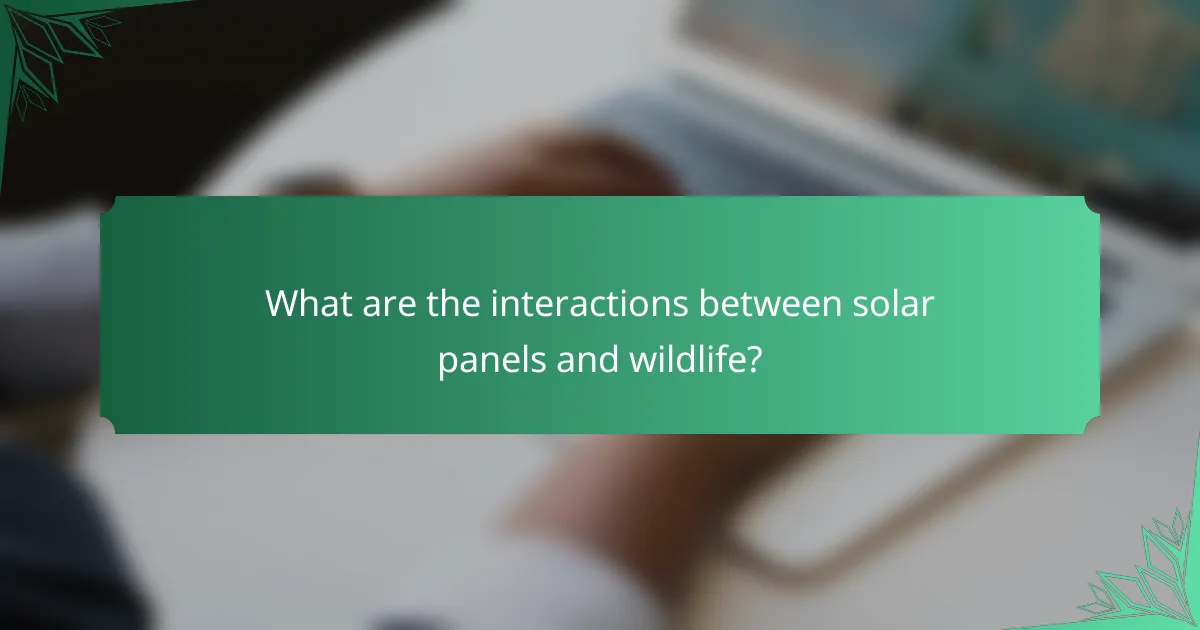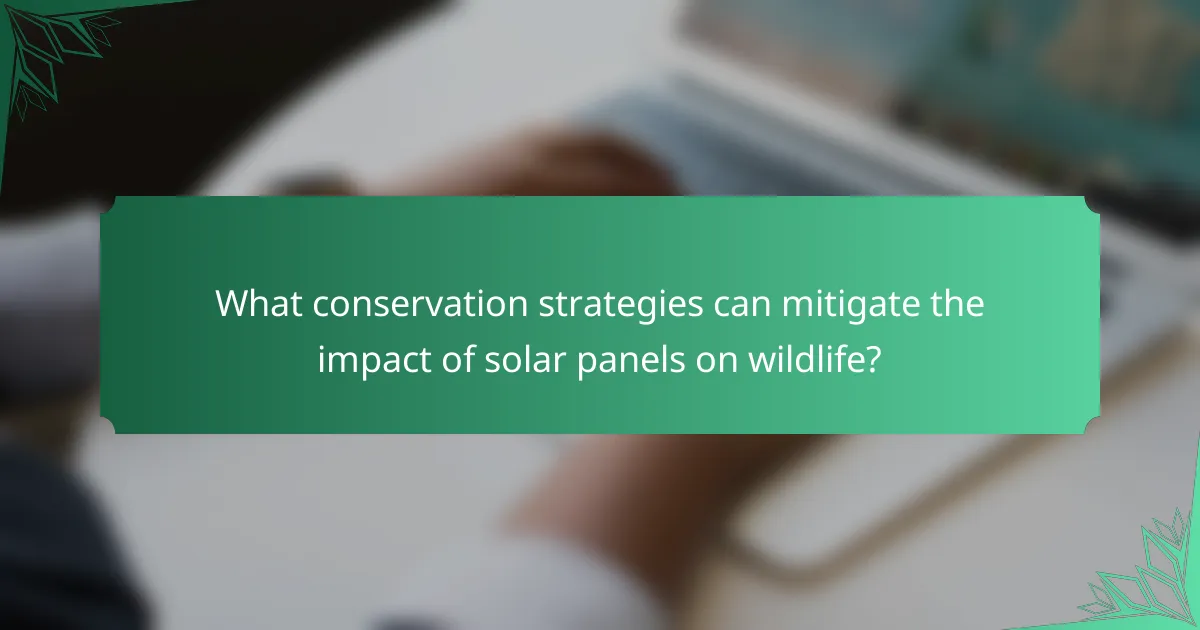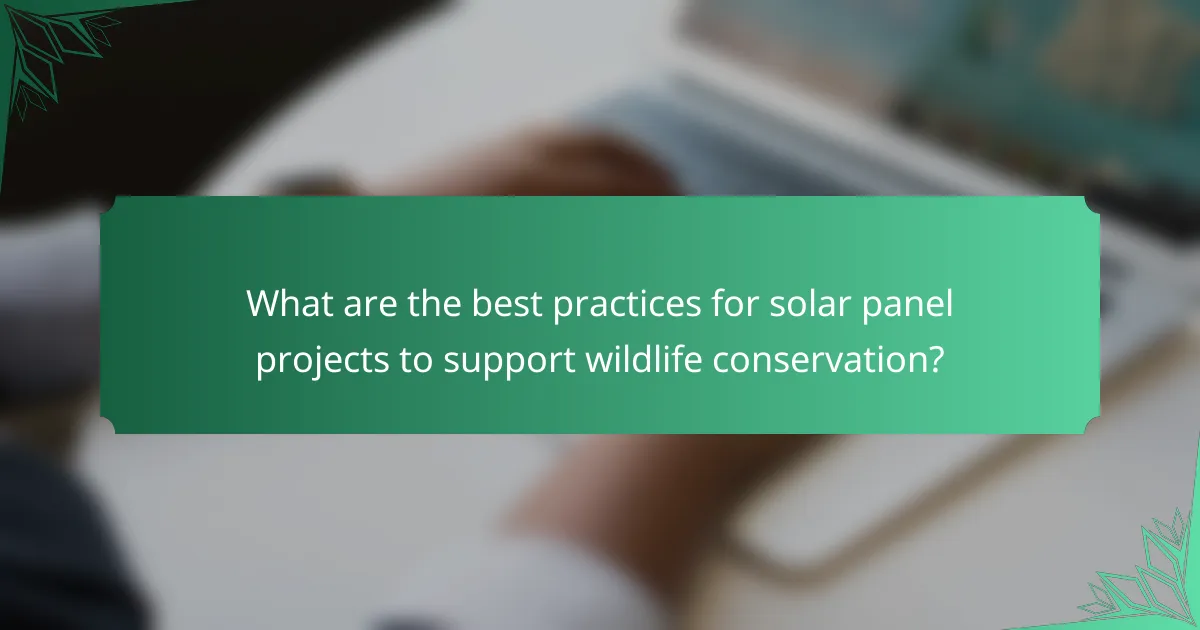
What are the interactions between solar panels and wildlife?
Solar panels can impact wildlife in various ways. They can provide habitat for certain species, such as birds and small mammals. The elevated structures create shaded areas that can support vegetation. This vegetation can attract insects, which in turn supports local bird populations. However, solar panels can also pose risks. Birds may collide with the panels, mistaking them for water surfaces. Additionally, habitat disruption can occur during installation. Research shows that proper site selection can mitigate negative impacts. For example, studies indicate that solar farms sited on degraded land minimize harm to wildlife. Overall, interactions between solar panels and wildlife are complex, with both positive and negative outcomes.
How do solar panels impact local ecosystems?
Solar panels can impact local ecosystems in various ways. They can alter land use patterns, leading to habitat loss for some species. The installation process may disturb soil and vegetation, affecting local flora and fauna. Solar farms can create microclimates, which might benefit certain species while disadvantaging others. In some cases, solar panels can provide new habitats for wildlife, such as nesting sites for birds. Research indicates that solar energy developments can lead to changes in species composition in the area. For example, studies show that solar farms can support pollinator populations by providing diverse plant life. However, the overall impact varies based on location and design of the solar installations.
What specific wildlife species are affected by solar panel installations?
Solar panel installations can affect several specific wildlife species. Birds are notably impacted, particularly raptors and migratory species that may collide with panels or associated structures. Desert tortoises are also affected, as their habitats can be disrupted by solar farms. Additionally, small mammals such as kangaroo rats may experience habitat loss due to land conversion for solar energy. Research indicates that solar farms can alter local ecosystems, leading to changes in species behavior and population dynamics. Studies have shown that these installations can create thermal effects, influencing the presence of certain species in the area.
How do solar panels alter natural habitats?
Solar panels can significantly alter natural habitats. They require land for installation, which may lead to habitat loss. This can disrupt local ecosystems and displace wildlife. The construction process can also cause soil erosion and sedimentation. Additionally, solar farms may introduce invasive species. These changes can affect biodiversity and alter species interactions. Research shows that habitat fragmentation can negatively impact animal movement and reproduction. Overall, while solar panels provide renewable energy, their installation must consider ecological impacts.
What are the potential negative effects of solar panels on wildlife?
Solar panels can negatively affect wildlife through habitat disruption and mortality. The installation of solar farms often requires land clearing. This process can destroy habitats for various species. Birds and bats may collide with solar panel structures. Studies indicate that these collisions can lead to fatalities. Additionally, solar farms can alter local ecosystems. Changes in land use can affect food sources for wildlife. Some species may be displaced due to the presence of solar installations. Research shows that these impacts can contribute to population declines in sensitive species.
What types of wildlife injuries or fatalities can occur near solar farms?
Wildlife injuries or fatalities near solar farms can include collisions, electrocutions, and habitat destruction. Birds often collide with solar panels or associated structures. This is particularly true for large solar installations. Electrocution can occur when animals come into contact with electrical components. Small mammals and reptiles may be affected by habitat loss due to land conversion for solar farms. Additionally, solar farms can disrupt local ecosystems. These factors can lead to a decline in certain wildlife populations. Studies indicate that mitigation strategies can reduce these impacts significantly.
How does light pollution from solar panels affect nocturnal species?
Light pollution from solar panels can disrupt nocturnal species’ behaviors. Nocturnal animals rely on natural light cues for navigation, hunting, and mating. Artificial light can lead to disorientation and altered activity patterns. For instance, studies show that artificial lighting can cause some species to become more active at inappropriate times. This change can affect predator-prey dynamics. Additionally, light pollution can interfere with the reproductive cycles of nocturnal species. The impact of solar panel light pollution on wildlife is an area of ongoing research.

What conservation strategies can mitigate the impact of solar panels on wildlife?
Conservation strategies to mitigate the impact of solar panels on wildlife include careful site selection and habitat preservation. These strategies ensure that solar installations do not disrupt critical habitats. Utilizing dual-use solar systems can also benefit wildlife. These systems allow agricultural activities to coexist with solar energy production. Implementing wildlife-friendly design features is another effective strategy. Such features can include bird-safe glass and fencing that allows animal movement. Monitoring and adaptive management practices help assess the impact of solar farms on local wildlife. Research shows that informed planning reduces habitat fragmentation. Studies indicate that proper management can minimize negative effects on biodiversity.
How can solar panel designs be improved for wildlife safety?
Solar panel designs can be improved for wildlife safety by incorporating features that minimize harm to animals. Designing panels with bird-safe glass can reduce collision risks. Elevating panels can create safe underpasses for small wildlife. Using non-reflective materials can decrease glare that disorients birds. Implementing fencing around solar farms can prevent wildlife intrusion. Additionally, integrating vegetation can provide habitat and food sources for local fauna. Research indicates that these modifications can significantly lower wildlife fatalities in solar installations. For instance, studies show that bird-safe designs can reduce collision rates by up to 90%.
What innovative technologies exist to reduce wildlife collisions?
Innovative technologies to reduce wildlife collisions include wildlife detection systems, animal overpasses, and infrared sensors. Wildlife detection systems use cameras and sensors to monitor animal movements near roadways. These systems can trigger warning signs for drivers when animals are detected. Animal overpasses provide safe crossing areas above or below roads for wildlife. These structures have been shown to significantly reduce collision rates in areas where they are implemented. Infrared sensors can detect the heat emitted by animals and alert drivers in real-time. Studies indicate that these technologies can lead to a reduction in wildlife-vehicle collisions by up to 80%.
How can solar farms incorporate wildlife-friendly features?
Solar farms can incorporate wildlife-friendly features by integrating natural habitats within their design. This can include planting native vegetation around solar panels. Such vegetation provides food and shelter for local wildlife. Additionally, solar farms can create buffer zones to protect sensitive ecosystems. These zones help maintain biodiversity in the area. Furthermore, installing pollinator gardens can support bee populations. Research indicates that solar farms can coexist with wildlife when designed thoughtfully. For example, a study by the National Renewable Energy Laboratory found that dual-use solar installations can benefit both energy production and local ecosystems.
What role do regulatory measures play in wildlife conservation around solar panels?
Regulatory measures play a crucial role in wildlife conservation around solar panels. They establish guidelines to minimize the impact of solar installations on local ecosystems. These regulations often require environmental assessments before project approval. They can mandate the implementation of wildlife-friendly designs. Examples include creating buffer zones and using bird-safe technologies. Compliance with these measures helps protect endangered species. They also promote habitat preservation during solar farm construction. Studies show that effective regulations lead to better conservation outcomes.
What guidelines are in place to protect wildlife during solar panel installation?
Guidelines to protect wildlife during solar panel installation include conducting environmental assessments. These assessments identify local wildlife populations and habitats. Site selection is crucial to avoid ecologically sensitive areas. Timing of installation should consider breeding and migration seasons to minimize disturbance. Implementing erosion control measures protects habitats from construction runoff. Training workers on wildlife protection practices is essential. Monitoring wildlife post-installation ensures ongoing protection efforts. These guidelines help mitigate negative impacts on wildlife during solar panel projects.
How can policymakers enhance protections for wildlife in solar energy projects?
Policymakers can enhance protections for wildlife in solar energy projects by implementing stringent environmental assessments. These assessments should evaluate the potential impacts on local ecosystems and species. Additionally, establishing designated wildlife corridors can help mitigate habitat fragmentation caused by solar installations. Policymakers should also promote the use of dual-use solar systems, allowing agricultural activities alongside solar panels. Incentivizing best practices for site selection can further minimize ecological disruption. Collaboration with conservation organizations can provide valuable insights for wildlife protection strategies. Lastly, ongoing monitoring and adaptive management practices are essential to ensure compliance and effectiveness of wildlife protections.

What are the best practices for solar panel projects to support wildlife conservation?
Best practices for solar panel projects to support wildlife conservation include site selection, habitat preservation, and wildlife-friendly designs. Site selection should avoid critical habitats and migration corridors. Habitat preservation involves maintaining native vegetation around solar installations. Wildlife-friendly designs can include elevated panels to allow animal movement underneath. Additionally, monitoring programs should be implemented to assess wildlife impacts. Research indicates that well-planned solar projects can coexist with wildlife, minimizing disruptions. For example, studies show that integrating solar farms with agricultural practices can enhance biodiversity.
How can land management practices be adapted for solar energy projects?
Land management practices can be adapted for solar energy projects by implementing strategies that promote ecological balance. These adaptations include maintaining native vegetation around solar installations. This practice supports local wildlife habitats and biodiversity. Additionally, integrating grazing practices with solar farms can enhance land use efficiency. Research indicates that managed grazing can coexist with solar infrastructure without compromising energy production. Furthermore, using dual-use systems allows for agricultural activities beneath solar panels. This approach maximizes land productivity while generating renewable energy. Implementing these adaptive practices can lead to sustainable solar energy development that benefits both energy production and environmental conservation.
What habitat restoration efforts can be implemented alongside solar farms?
Habitat restoration efforts that can be implemented alongside solar farms include the establishment of pollinator gardens. These gardens support local bee populations and other pollinators, which are crucial for ecosystem health. Additionally, native plant landscaping can enhance biodiversity. Native plants require less water and maintenance compared to non-native species.
Implementing erosion control measures is also vital. These measures prevent soil degradation and promote plant growth. Moreover, creating wildlife corridors can facilitate animal movement and reduce habitat fragmentation. These corridors connect habitats that may be separated by solar installations.
Restoration of wetlands around solar farms can improve water quality and provide habitat for various species. Lastly, incorporating grazing practices with livestock can manage vegetation and reduce fire risk. These strategies promote ecological balance while allowing solar farms to coexist with wildlife.
How can community engagement enhance wildlife conservation in solar projects?
Community engagement can enhance wildlife conservation in solar projects by fostering local stewardship and increasing awareness. Engaged communities are more likely to participate in conservation efforts. They can help identify important wildlife habitats affected by solar installations. Local knowledge can guide the design and placement of solar panels to minimize ecological disruption. Community involvement can also lead to the development of monitoring programs for wildlife health. Studies show that when communities are involved, conservation outcomes improve. For instance, projects with local input often see better compliance with wildlife protection measures. This collaborative approach leads to sustainable solar development that benefits both energy needs and biodiversity.
What are practical tips for ensuring wildlife conservation in solar energy initiatives?
Implementing wildlife conservation in solar energy initiatives involves several practical steps. Conduct thorough environmental impact assessments before project initiation. This helps identify potential risks to local wildlife. Utilize site selection strategies that avoid critical habitats. Prioritize areas with low ecological value for solar installations. Incorporate wildlife-friendly designs in solar infrastructure. This includes using fencing that allows animal passage. Schedule construction activities to avoid breeding seasons. This minimizes disruptions to wildlife during critical periods. Monitor wildlife populations post-installation. This ensures that conservation efforts are effective and adjustments can be made. Engage with local conservation groups for insights and collaboration. Their expertise can enhance conservation strategies. These practices help balance energy production with wildlife protection.
How can stakeholders collaborate to promote wildlife-friendly solar solutions?
Stakeholders can collaborate to promote wildlife-friendly solar solutions by engaging in multi-stakeholder partnerships. These partnerships can include government agencies, non-profit organizations, and solar developers. Collaborative efforts can focus on developing guidelines for solar site selection that consider wildlife habitats. Stakeholders can also share best practices for designing solar installations that minimize ecological impact. Engaging local communities in conservation efforts can enhance public support for wildlife-friendly initiatives. Furthermore, stakeholders can invest in research to assess the impacts of solar projects on local wildlife. Sharing data and findings can lead to more informed decision-making. By working together, stakeholders can create policies that incentivize wildlife-friendly practices in solar energy development.
What monitoring strategies can be used to assess wildlife impacts near solar panels?
Monitoring strategies to assess wildlife impacts near solar panels include wildlife surveys, remote sensing, and acoustic monitoring. Wildlife surveys involve direct observation and tracking of animal populations in solar panel areas. Remote sensing uses satellite imagery to analyze habitat changes and wildlife movement patterns. Acoustic monitoring records animal sounds to identify species presence and behavior. These strategies provide data on how solar installations affect local wildlife. Studies show that integrating these methods can lead to better conservation practices. For example, research published in “Environmental Management” highlights the effectiveness of combining wildlife surveys with remote sensing for comprehensive impact assessments.
The main entity of this article is solar panels and their interactions with wildlife. The article explores the complex relationship between solar panel installations and local ecosystems, detailing both positive impacts, such as habitat creation for certain species, and negative effects, including habitat disruption and wildlife collisions. It discusses specific wildlife species affected, conservation strategies to mitigate negative impacts, innovative design improvements for safety, and the role of regulatory measures in protecting wildlife. Additionally, the article outlines best practices for integrating solar energy projects with wildlife conservation efforts, emphasizing the importance of community engagement and collaboration among stakeholders.